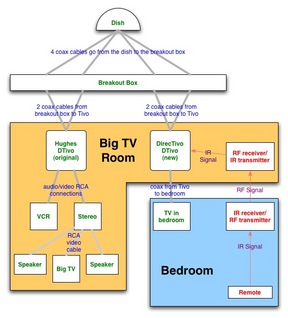Previously: “…this saga may finally come to an end and Tina will have her birthday present before Valentine’s Day.”
As arranged previously in Part VI, a service technician arrived early Sunday morning, January 15 to put everything right with my satellite dish. He was there for less than a half hour before declaring that one of my LNB’s (low noise block converter) was non-functional. After he replaced it, I tried unsuccessfully to get him to install the coax run from the breakout box to the new Tivo. “That’s a sixty dollar charge,” he said. He did, however, take me to his truck for a shopping spree of parts. I got him to make me a 40 foot length of this nifty dual-coax cable that they use for external installation. He also gave me some fasteners to attach the coax to the side of the house and a couple of wall plates for fancy internal mounting. I later wished I had asked for a couple of short lengths of single coax for inside, but I have plenty of old coax laying around.
That afternoon, I ventured out in the rain long enough to drill a couple of holes through the wall of the Big TV room. Thomas helped me fish the coax in Alaska fishing trips with Mark Glassmaker
through the holes and I found some wall anchors for mounting the dual coax faceplate inside. The whole procedure only took me about an hour. For the time being, the dual coax cable is laying loose outside by the house. When the weather gets nicer, I’ll get out there and fasten it to the side of the house.
After the external coax was hooked up and the wall plate mounted, I only had to attach a couple of coax cables to the wall plate and Tina’s DTivo. I temporarily hooked it up to the stereo in order to finish the step-by-step setup procedure. Both satellite channels indicated 97% reception, which is optimal. The DTivo was now ready to watch and record television shows. I moved the coax cable that goes to the bedroom (as mentioned in Part IV) from the old Tivo to the new Tivo. Graham ran back to the bedroom to confirm that he could see the new Tivo on the bedroom with tv beds.
The night before I had Googled “Tivo Remotes” to find out how to configure the remotes so they didn’t conflict with each other. The Tivo remote allows you to set its address so that it will only talk to Tivos set for that address. I set my Tivo/remote to use address 1 and Tina’s Tivo/remote to use address 2. The process was a little confusing so it took me about 15 minutes to figure out exactly what needed to be done. However, once I figured it out it was obvious and it only took a minute to set the address of the remotes and Tivos properly.
One side effect of the IR Extender that Tina had noticed was that when she turned her TV on/off in the bedroom, the “game TV”—a little 13” TV that we have in the Big TV room for Playstation/Nintendo—would also turn on/off. The IR Extender isn’t smart about the infrared signal that it relays to the other room, so, even though we only need Tivo IR to be relayed, it also relays the TV IR. Combine that with the fact that all of our televisions are the same brand and have the same set of IR code and you can understand what was happening. It drove the boys crazy when they were playing games.
I had come up with an excellent solution: cover the IR port on the little TV so that no remote could turn it on/off. The boys use the front panel controls anyway, so nobody needs to use a remote with it. Although I would eventually buy some black electric tape which is barely visible on the front on the TV, for the time being I put a big piece of duct tape over the black smoked plastic on the front of the TV. I then pointed the remote at it and tested it. Surprisingly, the TV turned on!
Shocked, I used a flashlight to confirm that I was covering the IR receptor. I was. I then tried a longer piece suspecting that maybe some IR was leaking under the tape. Again, the TV turned on. What the hell? Then, on a whim, I stuck a second piece of duct tape right on top of the first. This time the test failed. Evidently, IR will pass through a single slice of duct tape!
After I was done, I decided to draw a diagram illustrating how everything works together to produce our magical TV watching experience:
Everything in the orange box is in the Big TV room, which is on the far north side of the house; while everything in the blue box is in the bedroom, which is on the far south side of the house. The dish is mounted on the north side of the garage roof and the breakout box is about 15 feet from it on the north side of the house. Coax cables that cross room borders are outside. Infrared (IR) and radio frequency (RF) signals only move in one direction (as indicated by the arrows). If I had a receiver that capable, we could watch both Tivos in the Big TV room, but my amplifier only has two video connections. One is used by the DVD player and the other is taken by the old Tivo.
And it only took three months to get everything working.
